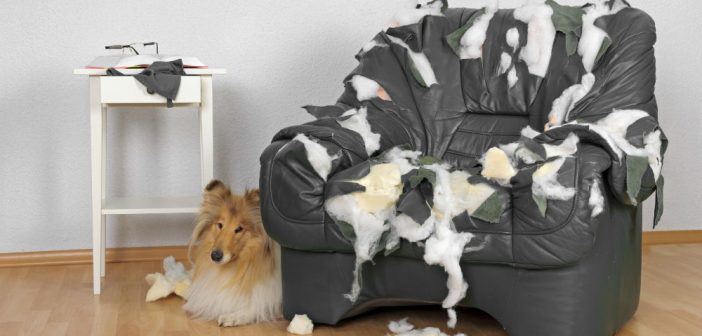Some pet-owners are content to let their furry friends lounge on the furniture all day, but that’s not always an option. Maybe your cat insists on shredding couch cushions and leaving clumps of fur behind. Maybe your fragile old chihuahua has a habit of hiding under blankets, where he risks being sat on and hurt. Maybe your Spanish mastiff drools everywhere and you’d rather not have to cover your sofa in plastic every day. Whatever the reason, it’s perfectly valid to not want pets on the furniture for some or all of the time. It may seem impossible to train your pets to stay on the floor, but that’s not the case. Training them to stay off the furniture just takes some patience and consistency.
Why Do Pets Climb On Furniture?
There are some misinformed dog trainers and owners out there who believe that dogs sleep on furniture to establish dominance. That’s a silly idea with no evidence behind it. The truth is pets like beds and sofa for the same reason we do; it’s comfortable.
Another misconception is cats claw furniture to “get back” at their owners, but this is false. Animals have no concept of revenge and never do things out of spite. Cats claw to keep their nails trimmed. Even cats that have been declawed will instinctively attempt to “claw” things” because it is a part of their feline nature. All cats claw, that’s just a fact. Thankfully, cats can be persuaded to leave your furniture alone and use a scratching post instead.
Dog Beds and Cat Condos
All pets deserve a soft, warm place to sleep. A dog bed can be placed in a corner with a favorite blanket, a nice treat to chew on or a pet-safe stuffed animal. A trained dog can be taught to “lie down” and “stay” in the dog bed, until eventually he or she will use it out of habit.
Cats are a bit trickier, not only do they need to claw, but they also enjoy the act of climbing itself. Have you ever noticed your feline friend perching on a tall bookshelf, a windowsill or in the space between the ceiling and kitchen cabinets? Cats have an instinctive need to climb and sit in high places, so a small bed on the floor just won’t cut it. Cat condos, also called kitty condos, are a better choice for felines. Cat condos have built-in scratching posts and hiding holes, satisfying their need to claw and climb. For multi-cat households, more than one cat condo may be necessary if the cats are unwilling to share.
Deterring Cats and Dogs from Furniture
What if you have provided alternatives but your animals insist on ruining your furniture? Sometimes this happens since dogs and cats are both creatures of habit. If they have been sleeping on the sofa every day for the past five months, they are not going to suddenly stop without a good reason. That’s where deterrents come in handy.
There are many types of deterrents aimed at keeping pets off of couches and away from garbage bins. Some deterrents are high-tech, expensive and make loud beeping sounds when a pet climbs on the couch. However, you can make your own natural, noise-free pet repellent.
If you have dogs, you can use peppers as a deterrent. All you need is a spray bottle, some water and cayenne pepper flakes. Combine a small spoonful of pepper flakes with a good amount of water to make sure it is sufficiently diluted. Mix well. Spray it on furniture that is off-limits for pets. Just be sure to test it first because certain types of furniture can be stained by these sprays.
Be aware, pepper deterrents are not safe for households with cats, rabbits or certain other pets. Use of hot pepper on furniture where cats may walk is cruel because it will get on their paws and as they groom themselves, hot pepper will get in their eyes, mouth and nose. A safe alternative suitable for cats is vinegar water and it repels most dogs too. Just add water to a bit of vinegar, pour into a spray bottle and spray it on furniture. Like pepper spray, this vinegar solution might stain some types of furniture.
For most pets, providing alternatives and using natural deterrents will work to keep the pets off the couch. However, if your dog growls when told to get off the couch or exhibits other signs of aggression, talk to your veterinarian about behavioral problems and consider finding a knowledgeable dog trainer.








